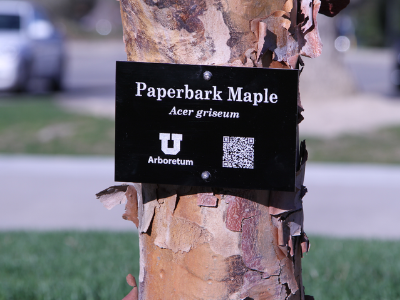The University of Utah Tree Tour
The University of Utah Campus is a State Arboretum.
In 1930, Dr. Walter P. Cottam, co-founder of The Nature Conservancy and chairman of the Botany Department at the University of Utah, began using campus land for plant research. For more than 30 years, he evaluated plants to determine their adaptability to our region.
In 1961, the Utah State Legislature formally recognized Cottam’s impressive collection by designating the University's campus landscape as a State Arboretum. The original legislation mandated that the Arboretum "provide resources and facilities for cultivating a greater knowledge and public appreciation for the trees and plants around us, as well as those growing in remote sections of the country and world."
Visit the Tree Tour
For more information:
QR Code Feature
The Sustainable Campus Initiative Fund (SCIF) oversees competitive grants for student projects focused on sustainability education, environmental issues, energy efficiency, and more. SCIF’s mission is to provide funding for real-world projects that improve the U’s environmental quality and make the campus more sustainable.
In 2015, SCIF students partnered with Facilities Management to work on the grant project, “Discovering Our Campus Arboretum”.
This project was an effort to bring awareness to the University’s urban forest, these students updated the tree plaques on campus. The plaques now include a digitally accessible QR code.
The new plaques create a visual gateway to more information by connecting to a Tree Tour that people can experience both virtually and physically, via interactive maps.

The public can scan the QR code to learn more about the trees around Campus.
Ash
Flowering Ash (Manna Ash)
German Ash
Green Ash
Velvet Ash (Dixie White Ash)
White Ash
Beech
European Beech
Tricolor Beech
Weeping European Beech
Birch
Paper Birch
Western Red Birch (Water Birch)
Catalpa
Northern Catalpa (Western Catalpa)
Umbrella Catalpa
Cedar
Blue Atlas Cedar
Incense-cedar
Weeping Blue Atlas Cedar
Cherry and Plum
Chokecherry
Japanese Flowering Cherry
Purpleleaf Plum
Chitalpa
Coffee Tree
CorkTree
Crabapple
Dawn Redwood
Douglas Fir
Elm
American Elm
Lacebark (Chinese Elm)
False Cypress
Lawson Falsecypress
Weeping Nootka Falsecypress
Filbert
Contorted Filbert (Harry Lauder's Walkingstick)
Fir
Ginkgo
Goldenchain Tree
Goldenrain Tree
Hackberry
Hawthorn
Cockspur Hawthorn
English Hawthorn
Lavalle Hawthorn
Washington Hawthorn
Honeylocust
Hornbeam
Horsechestnut or Buckeye
European Horsechestnut
Ohio Buckeye
Red Horsechestnut
Yellow Horsechestnut (Sweet Buckeye)
Japanese Lilac Tree
Juniper
Linden
American Linden
Littleleaf European Linden
Locust
Magnolia
Saucer Magnolia
Southern Magnolia
Star Magnolia
Maple
Amur Maple
Bigtooth Maple (Canyon Maple)
Freeman Maple
Hedge Maple
Japanese Maple
Norway Maple
Paperbark Maple
Rocky Mountain Maple
Sycamore Maple
Tatarian Maple
Mimosa
Mountain Ash
European Mountain-ash (Rowan Ash)
Mulberry
Oak
Bur Oak
Columnar English Oak
Cork Oak
Eastern Red Oak
Gambel or Scrub Oak
Mongolian Oak
Osage Orange
Pagoda Tree
Pea Tree/Shrub
Pear
Pine
Austrian Pine
Bosnian Pine
Bristlecone Pine
Himalayan or Bhutan Pine
Lacebark Pine
Limber Pine
Pinyon Pine
Ponderosa Pine
Scotch Pine
Poplar
Redbud
Rubber Tree
Sequoia
Serviceberry
Smoketree
Spruce
Blue Spruce
Oriental Spruce
Weeping Norway Spruce
